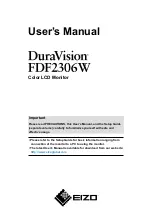
57
Using Discrete IR Codes
The display accepts commands in the form of infrared (IR) signals that conform to the NEC protocol. Each display remote
control button has an IR control code associated with it.
You can use these codes to program a third-party, “universal” remote control unit to work with the display. These third-
party products usually come with a computer software application for this purpose. For more information, consult the
documentation provided with the remote control unit.
IR Command Protocol
The IR control codes have the following characteristics:
•
Each code consists of the following:
A leader pulse (a modulated pulse of 9 ms followed by a non-modulated pulse of 4.5 ms);
16 address bits (also called a “custom code”): eight (8) bits for the address followed by the logical inverse of the
address. The custom code for the display is 16559 decimal (0x40AF, binary 01000000 10101111).
16 da ta bits: eight (8) bits for the command followed by the logic al inverse of the command; and
An end pulse (a modulated pulse of 0.56 ms, similar to the modulated pulse in the ‘0’ and ‘1’ bits). The end of
the modulated pulse constitutes the end of the data transmission.
•
The carrier frequency is 38 kHz, with the modulated pulses having a 33% duty cycle.
•
Commands are sent at a maximum rate of 9 Hz.
For example, here is the NEC control code for the POWER button on the display remote control unit:
Hex
40
AF
1C
E3
Binary
01000000
10101111
00011100
11100011
Function
Cust. Code Byte 1
Cust. Code Byte 2
Command
Command
(Logical Inverse)
Summary of Contents for VTE-8400
Page 1: ...VTE 8400 Super slim LED Display Model VTE 8400 Installation OperationManual ...
Page 6: ...6 Notes ...
Page 10: ...10 Notes ...
Page 14: ...14 VGA Cable HDMI Cable Quick Start Guide USB Key Multi Touch Drivers User Manual ...
Page 15: ...15 Notes ...
Page 60: ...59 Notes ...
Page 64: ...63 Notes ...
Page 68: ...67 Appendix IV Wall Mount Safety Notes ...
Page 69: ...68 ...












































